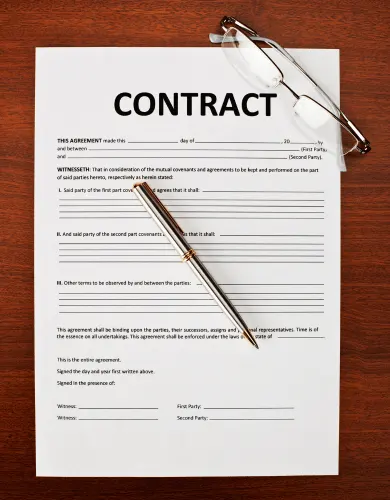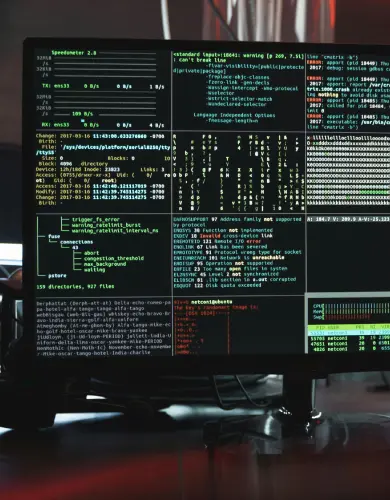Is 5G faster than fibre broadband?
The table below summarises the latest data comparing the speed of 5G versus fibre broadband connections.
| Broadband type | Max real world speeds | Typical Speeds |
|---|---|---|
| 5G | 1,000 Mbps | 150 - 200 Mbps |
| SoGEA (FTTC) | 80 Mbps | 50 - 60 Mbps |
| Full Fibre | 1,000 Mbps | Usually as advertised |
This article provides an expert analysis of fibre and 5G broadband speeds. The key takeaway is that 5G technology can deliver fast internet to your business at a lower cost. However:
- 5G speeds depend on the distance of your property from your provider’s nearest antenna, making it only a suitable alternative to fibre in certain locations.
- 5G speeds are less consistent than fibre, as they are impacted by weather conditions and the number of nearby users.
The obvious difference between 5G and fibre broadband is that fibre optic is a tethered connection using physical cables, whereas 5G uses wireless technology.
This distinction has important implications for the reliability of internet speeds delivered by both connections, which we will explore in this article.
Broadband speed – 5G versus fibre
Below, we compare the broadband speeds reported by official Ofgem statistics.
- 5G – The average download speeds in the UK range between 74 Mbps and 235 Mbps.
- Fibre-to-the-cabinet broadband – An average download speed of 56 Mbps in the UK in 2023
- Full fibre – An average download speed of 150 Mbps in the UK in 2023.
Sources: Ofcom, ISPpreview
The statistics show that full fibre is the fastest, with 5G slightly slower and part-fibre (FTTC) slower than both by a larger margin.
The average speed of full fibre broadband is significantly below the maximum available because businesses often choose cheaper, slower packages.
Choice of speed – 5G versus fibre
There is a significant difference in the range of speed choices available in 5G compared with fibre contracts:
- 5G business broadband – No choice in speed. The speed available will be principally determined by proximity to a 5G antenna.
- SoGEA business broadband – Typically only offered at a single speed of approximately 70Mbps.
- Full fibre business broadband – Typically offered with speeds ranging from 150 to 1,000 Mbps. Business broadband price rises with the chosen speed.
Latency 5G versus fibre broadband
Download speed isn’t the only metric for comparing 5G to fibre performance.
Latency will determine the quality of video and VoIP calls; here’s how they compare.
- 5G average latency in the UK ranges between 18ms and 22ms.
- Fibre-to-the-cabinet broadband experienced latencies of 10ms to 13ms in 2023.
- Full fibre broadband experienced latencies of 4.9ms to 7.3ms in 2023.
Source: Ofcom
Fibre broadband (full and FTTC) is significantly more responsive (lower latency) than 5G, thanks to its tethered nature.
What factors affect 5G and fibre broadband speeds?
Factors affecting 5G speeds
- Network congestion: If many devices are connected to the 5G network simultaneously (e.g. peak times, special events), it is possible to experience network congestion and, therefore, slower speeds.
- Distance from the antenna: The further a device is from a 5G antenna, the weaker the signal strength and the slower the speed. This effect is exacerbated during bad weather.
- Physical obstructions: Buildings, trees, and even weather can obstruct 5G signals, impacting speed.
- Provider infrastructure: The data transmitted by 5G antennas depends on the quality of the provider’s infrastructure; some 5G networks are faster than others.
Factors affecting fibre broadband speeds
- Distance from the exchange: For fibre-broadband connections that include copper wires like SoGEA, the further your property is from the telephone cabinet, the slower the speed. It is estimated that every 100 metres reduces download speeds by up to 20 Mbps.
- Quality of internal wiring: If the internal wiring in a property is old or poorly installed, it can cause electrical interference, signal degradation, and slower broadband speeds. This is especially important in an FTTC connection that relies on copper phone lines.
- Hardware: Older business broadband routers and connected devices may not support the fastest fibre broadband speeds. For example, an older PC may not be capable of processing a gigabit internet connection.
Real-life 5G and fibre broadband speed tests
Going by the famous web 3.0 adage: “Don’t trust, Verify!” we decided to compile real-world speed tests performed by YouTubers in the UK to check if speeds are consistent with the ‘official’ statistics.
| Provider (Location) | Technology | Download Speed | Latency |
|---|---|---|---|
| Vodafone (Leeds) | FTTP 910 (Full-Fibre) | 937 Mbps | 6 ms |
| Plusnet (London) | FTTP 500 (Full-Fibre) | 458 Mbps | 6 ms |
| Talk Talk (Manchester) | FTTP 500 (Full-Fibre) | 515 Mbps | 3 ms |
| BT (London) | FTTP 900 (Full-Fibre) | 929 Mbps | 7 ms |
| Talk Talk (Welwyn) | FTTC | 58 Mbps | 12 ms |
| Sky (Maidenhead) | FTTC | 74 Mbps | 8 ms |
| Talk Talk | FTTC | 74 Mbps | 8 ms |
| Three Mobile (London) | 5G | 426 Mbps | 25 ms |
| Three (London) | 5G | 600 Mbps | 13 ms |
| Vodafone (Bristol) | 5G | 502 Mbps | 33 ms |
| Three (Blackpool) | 5G | 795 Mbps | 63 ms |
Note: There may be bias in these tests as they’re sourced from a social media platform.
Fibre versus 5G speeds – FAQs
While we’re at it, here are our answers to frequently asked questions regarding 5G and fibre broadband speeds.
How does network congestion impact 5G and fibre broadband speeds in the UK?
Network congestion reduces the speed of any internet connection under any circumstance. While 5G and fibre broadband are the latest technologies with the largest capacity for data transfer in mobile and broadband connections, respectively, they can still experience congestion at peak times.
Business broadband deals are generally protected from traffic management, as business broadband providers prioritise commercial traffic over household traffic at peak times.
Does distance from the source affect the speed of 5G and fibre broadband?
Yes, but it affects each technology differently, as follows:
- 5G: As a high-frequency cellular technology, the signal can transmit large volumes of data but also degrades rapidly over distance. 5G networks are very sensitive to distance from the antennas, obstructions and even weather, which is why a high density of antennas is necessary.
- FTTC: Since part of the connection is still supported by copper wire, the longer the distance from the cabinet to your router, the slower the connection. It is estimated that every 100 meters reduces download speeds by up to 20 Mbps.
- Full fibre: Since the entire path from source to router is composed of fibre optics transmitting data at close to the speed of light, the effect of distance on full fibre is minimal, if negligible.
How do physical obstructions influence 5G and fibre broadband speeds?
Physical obstructions significantly affect 5G speeds, as walls, trees, or rain can block or weaken the signal.
On the other hand, fibre broadband is unaffected by physical obstructions unless the cables are physically damaged.
What role does hardware play in the speeds of 5G and fibre broadband?
Hardware can either enable or bottleneck 5G and fibre broadband connections.
For 5G, devices must be compatible with the network and support the specific frequency band of your mobile business broadband provider. Additionally, faulty or unsophisticated antennas can dramatically hamper 5G speeds.
For fibre broadband, the quality and specifications of the router have a significant influence on speed. An older or lower-quality router may not support the maximum speeds offered by your broadband package. The same applies to the devices connected to your router via WiFi or an Ethernet cable; if they’re too old, they are unlikely to support the speeds offered.
Can weather conditions affect 5G and fibre broadband speeds?
Yes, weather can affect 5G, as heavy rain, snow, or even dust can absorb or scatter its signals, reducing speed and coverage. Being a tethered connection, fibre broadband is immune to weather conditions, except when extreme weather damages the cables, such as falling trees in storms.
Why might 5G offer faster speeds in some areas but not others?
5G technology operates through a range of frequency bands. Higher-frequency millimetre-wave bands offer faster speeds but have shorter ranges and can be easily obstructed, while lower-frequency bands provide better coverage but at slower speeds.
Ofcom determines the frequency bands that mobile operators can utilise, ultimately impacting the available speeds.
Can fibre broadband maintain consistent speeds better than 5G?
Generally, yes. Fibre broadband is less affected by factors that can disrupt 5G, such as physical obstructions, distance from the antenna, network congestion, or even the weather. However, the actual performance can vary based on your specific location, service, and even the hardware you use.

